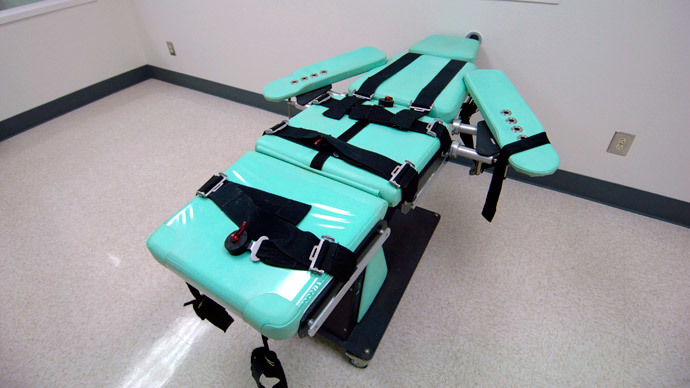Oklahoma sparks concerns after unveiling new lethal injection drug combo

The state of Oklahoma unveiled on Tuesday the controversial three-drug combination it plans to use to kill two death row inmates via lethal injection later this month.
According to NBC News, the announcement was made in a letter by the state’s attorney general and was confirmed by lawyers for the convicted killers, Clayton Lockett and Charles Warner, who are set to be executed on April 22nd and 29, respectively.
The state said it would use a combination of the sedative midazolam, the muscle relaxer pancuronium bromide, and potassium chloride in the lethal injection procedure.
This combination is an “untested” mixture, NBC reported, but the Associated Press claims it has been used before in Florida.
The move comes about one week after a state judge ruled that Oklahoma cannot keep secret the type of drugs it plans to use during an execution, nor could it hide the source – a decision that will likely be appealed by the state. As RT reported previously, many states face severe shortages of various drugs often used in lethal injections, largely due to the fact that many of the manufacturers are European companies opposed to capital punishment.
Less than two weeks ago, Oklahoma expanded its execution protocol to allow for various drug combinations to be used. Its decision to move forward with this three-drug combo, however, was met with skepticism from the inmates’ lawyers, who fear it will cause undue pain and suffering.
"This combination of drugs has been used in a handful of executions in Florida and has raised questions because midazolam is not an anesthetic drug and it is therefore unclear whether it will adequately anesthetize a prisoner prior to the second and third drugs, which will unquestionably cause pain and suffering in an inadequately anesthetized person," Warner’s lawyer Madeline Cohen told the AP.
Additionally, the inmates’ attorneys told NBC that since the planned dosage of midazolam is even smaller than the one used in Florida, there is a "serious and substantial risk that the condemned prisoner will not be adequately anesthetized before he is injected" with the remaining drugs.
As a result, if the low dose of midazolam does not work as intended, the lawyers claim the other two components could cause the victim severe pain and discomfort, a violation of the inmates’ right against cruel and unusual punishment.
In response, the attorney general’s office said the Oklahoma Department of Corrections will conduct an analysis of the two drugs – developed at unnamed compounding pharmacies instead of being purchased from known manufacturers.
"Additionally, ODOC will disclose to you the certificate of analysis provided with the raw ingredients used to compound the midazolam and pancuronium bromide," the state wrote, according to the AP.
Speaking with the Guardian, Richard Dieter of the Death Penalty Information Center expressed his concern with practices done at compounding pharmacies, saying the staff there may not be as knowledgeable about the steps necessary to create the drugs, affecting the final product.
"Each pharmacist may prepare the drug slightly differently, and even one day's dose may differ from another,” he said. “Moreover, there has been recent evidence of contaminated drugs from compounding pharmacies causing severe and deadly reactions. Any of these factors could cause the first drug in a lethal injection to be less than 100 percent effective, thereby exposing the inmate to the risk of observing his own slow death."














